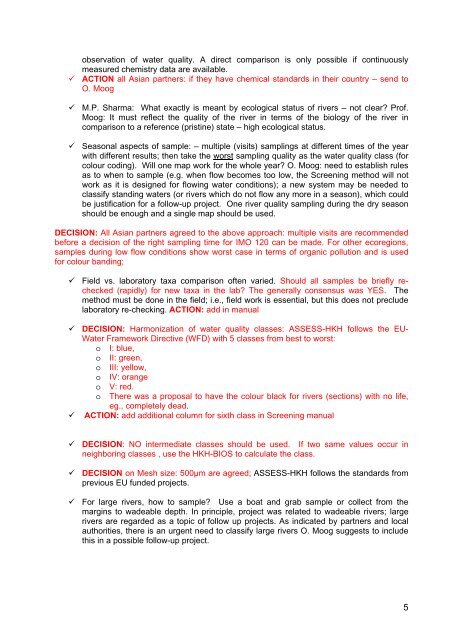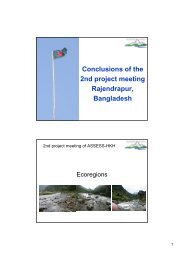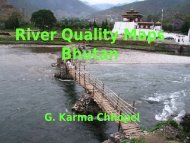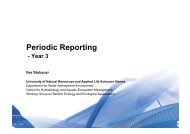2007 - ASSESS-HKH
2007 - ASSESS-HKH
2007 - ASSESS-HKH
You also want an ePaper? Increase the reach of your titles
YUMPU automatically turns print PDFs into web optimized ePapers that Google loves.
observation of water quality. A direct comparison is only possible if continuously<br />
measured chemistry data are available.<br />
ACTION all Asian partners: if they have chemical standards in their country – send to<br />
O. Moog<br />
M.P. Sharma: What exactly is meant by ecological status of rivers – not clear Prof.<br />
Moog: It must reflect the quality of the river in terms of the biology of the river in<br />
comparison to a reference (pristine) state – high ecological status.<br />
Seasonal aspects of sample: – multiple (visits) samplings at different times of the year<br />
with different results; then take the worst sampling quality as the water quality class (for<br />
colour coding). Will one map work for the whole year O. Moog: need to establish rules<br />
as to when to sample (e.g. when flow becomes too low, the Screening method will not<br />
work as it is designed for flowing water conditions); a new system may be needed to<br />
classify standing waters (or rivers which do not flow any more in a season), which could<br />
be justification for a follow-up project. One river quality sampling during the dry season<br />
should be enough and a single map should be used.<br />
DECISION: All Asian partners agreed to the above approach: multiple visits are recommended<br />
before a decision of the right sampling time for IMO 120 can be made. For other ecoregions,<br />
samples during low flow conditions show worst case in terms of organic pollution and is used<br />
for colour banding;<br />
Field vs. laboratory taxa comparison often varied. Should all samples be briefly rechecked<br />
(rapidly) for new taxa in the lab The generally consensus was YES. The<br />
method must be done in the field; i.e., field work is essential, but this does not preclude<br />
laboratory re-checking. ACTION: add in manual<br />
DECISION: Harmonization of water quality classes: <strong>ASSESS</strong>-<strong>HKH</strong> follows the EU-<br />
Water Framework Directive (WFD) with 5 classes from best to worst:<br />
o I: blue,<br />
o II: green,<br />
o III: yellow,<br />
o IV: orange<br />
o V: red.<br />
o There was a proposal to have the colour black for rivers (sections) with no life,<br />
eg., completely dead.<br />
ACTION: add additional column for sixth class in Screening manual<br />
DECISION: NO intermediate classes should be used. If two same values occur in<br />
neighboring classes , use the <strong>HKH</strong>-BIOS to calculate the class.<br />
DECISION on Mesh size: 500µm are agreed; <strong>ASSESS</strong>-<strong>HKH</strong> follows the standards from<br />
previous EU funded projects.<br />
For large rivers, how to sample Use a boat and grab sample or collect from the<br />
margins to wadeable depth. In principle, project was related to wadeable rivers; large<br />
rivers are regarded as a topic of follow up projects. As indicated by partners and local<br />
authorities, there is an urgent need to classify large rivers O. Moog suggests to include<br />
this in a possible follow-up project.<br />
5






